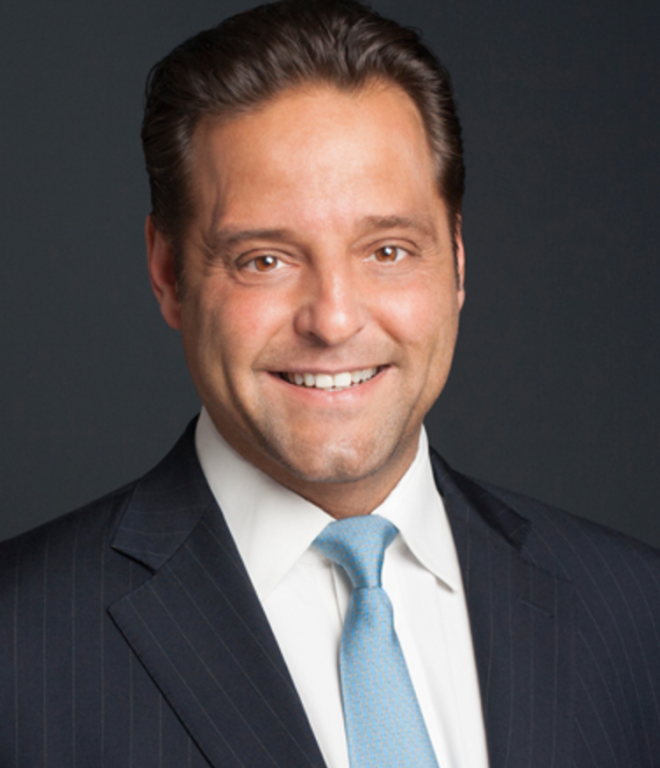Atlanta’s Mercedes-Benz Stadium, the brand-spanking-new home of the NFL’s Falcons and MLS’ Atlanta United has drawn praise for several firsts in stadium design since its opening this summer. The oculus-shaped roof and the scoreboard that wraps around the perimeter of the interior of the stadium roof are but two examples. A third and, to GreenSportsBlog, most important first, came to light last week when it was announced Mercedes-Benz Stadium had earned LEED Platinum certification, the first pro stadium^ to do so.
88.
While we are living in the “Moneyball” era of sports, dominated by complex, advanced statistics, that simple number may be the most significant metric of the year.
You see, 88 represents the most LEED points earned to date by any sports facility in the world. Atlanta’s Mercedes-Benz Stadium amassed that haul to become the first pro stadium to attain LEED Platinum level certification from the U.S. Green Building Council. For those keeping score at home, 80 points is the minimum threshold for LEED Platinum.

Aerial view of Mercedes-Benz Stadium in Atlanta (Photo credit: AMB Sports and Entertainment)
Getting to 88 points didn’t just happen. It took an anything-is-possible vision and a consistent commitment to sustainability — from both environmental and community development points of view — from Arthur Blank, Owner and Chairman of the two teams.
“We set out to build a venue that would not only exceed expectations, but also push the limits of what was possible in terms of stadium design, fan experience and sustainability,” noted Blank. “[Our] goal was to achieve the highest LEED rating because it was the right thing to do for our city and the environment and with this achievement, we have a powerful new platform to showcase to the industry and to our fans that building sustainably and responsibly is possible for a venue of any type, size and scale.”
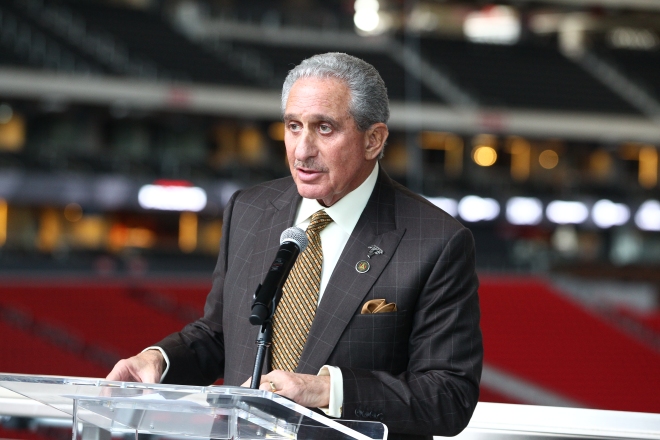
Arthur Blank, owner of the Atlanta Falcons and Atlanta United, speaking at the LEED Platinum announcement event for Mercedes-Benz Stadium (Photo credit: AMB Sports and Entertainment)
Blank’s innovative vision was executed by Scott Jenkins, General Manager of Mercedes-Benz Stadium, along with a team that included leading sports architecture firm HOK. “One of the reasons we were able to get to 88 points was that we aggressively pursued innovation credits, one of the newer elements of LEED,” offered Jenkins. “Arthur pushed the team to innovate in water, lighting, energy conservation, as well as in community development and social equity programming.” Here are some examples:
- Mercedes-Benz Stadium earned every available LEED water credit by:
- Using 47 percent less water than baseline standards due to water-efficient fixtures and conservation infrastructure
- Building a 1.1 million gallon, underground water vault, providing the area with much-needed flood management
- Storing another 680,000 gallons of water for use in irrigation and the stadium’s cooling tower
- Restoring water to the nearby Flint River#
- Partnering with community organizations like Trees Atlanta to share captured rainwater for tree irrigation
- The stadium’s 4,000 solar panels power the equivalent of nearly ten Falcons games or 13 Atlanta United matches with clean, renewable energy. An important feature of the installation, said Jenkins, is that “most of the panels are visible to fans, as parking lot canopies and atop an underground garage.”
- LED lighting throughout the building will reduce energy usage by as much as 60 percent
- Three nearby MARTA light rail stations have resulted in 25-30 percent of fans taking mass transit to attend Falcons and Atlanta United games
- Copious alternative transportation options, including a bike valet program, EV charging stations with capacity to charge up to 48 electric cars simultaneously and new pedestrian-friendly walking paths, provide more connectivity between communities
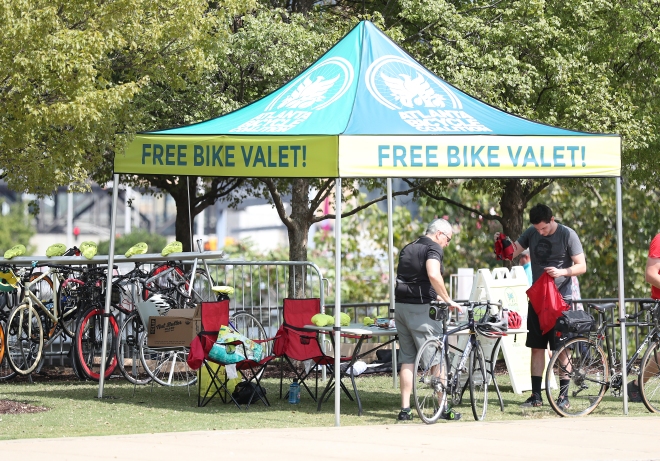
Fans dropping off their bikes at Mercedes-Benz Stadium’s free bike valet at September’s Atlanta United-Orlando City match (Photo credit: AMB Sports and Entertainment)
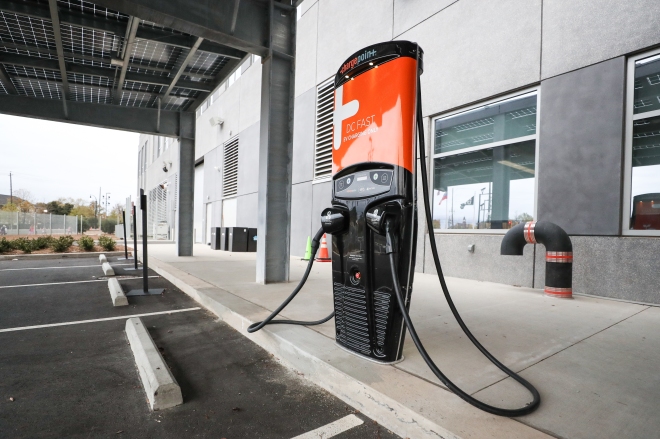
EV charging station adjacent to Mercedes-Benz Stadium (Photo credit: AMB Sports and Entertainment)
- Partnerships with local organizations are training residents in the stadium’s Westside neighborhood in nursing, construction, culinary arts, IT and automotive with the goal of placing them in living wage jobs in the industry
The remains of the Georgia Dome, the Falcons’ prior home which was imploded Monday, will be handled in an environmentally sound fashion: 98 percent of its materials will be reused and thus will not end up in a landfill. One might expect a parking lot to take its place. But that was not what Blank had in mind. Instead, after the Dome’s concrete fills the hole the implosion created; after the metal and steel is salvaged, the Home Depot Backyard will open on that site next August. It will boast 13 acres of new greenspace and parkland for arts and cultural events, entertainment and community building on non-event days. Tailgaters will rule the roost on game days.
Blank’s sustainable vision extends beyond the stadium and environs. “It certainly was not lost on Arthur that, while Mercedes-Benz Stadium is situated in very close proximity to Spelman College, Martin Luther King’s childhood home and other sites of significance to the civil rights movement, it is also close to two very poor communities” shared Jenkins. “That’s a big reason why he made a significant investment in the Westside, going beyond even what was necessary to earn Platinum certification to make the stadium a focal point for new employment and community development opportunities.”
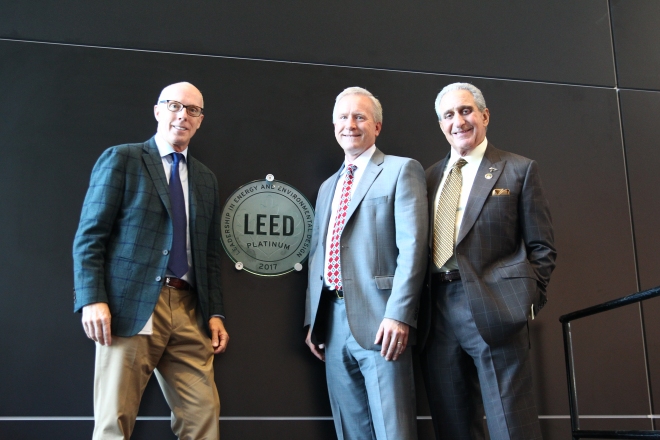
Scott Jenkins (c), General Manager of Mercedes-Benz Stadium, flanked by Rich McKay (l), President of the Atlanta Falcons and Arthur Blank, at the LEED Platinum announcement event (Photo credit: AMB Sports and Entertainment)
It must be noted that, while Mercedes-Benz Stadium’s 88 is the best LEED score ever, it’s not perfect.” Hey, I am a stickler!
So how can Blank and Co. improve on things? According to Jenkins, “we’re looking at reducing plastic usage — straws, for example — as well as increasing our vegetarian, vegan and healthy food offerings.”
These are worthy goals, indeed, and are examples of how Mercedes-Benz Stadium is taking the notion of sustainable sports venues to an entirely new level.
^ Sacramento’s Golden 1 Center is the first LEED Platinum-certified arena and the University of North Texas’ Apogee Stadium is the first collegiate stadium to earn that designation
# The Flint River is not to be confused with the city of Flint, MI, which, of course, which is living through its own serious water issue.


